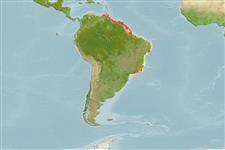Environment: milieu / climate zone / depth range / distribution range
Ecología
marino; agua dulce; salobre; rango de profundidad ? - 40 m (Ref. 188). Tropical; 12°N - 26°S, 64°W - 33°W (Ref. 188)
Western Atlantic: Trinidad and the Guianas; from Sergipe south to about Rio de Janeiro. Also found in freshwater. Also southern Brazil (Ref. 26938).
Tamaño / Peso / Age
Maturity: Lm ? range ? - ? cm
Max length : 22.0 cm TL macho / no sexado; (Ref. 125970); common length : 12.0 cm TL macho / no sexado; (Ref. 5217); peso máximo publicado: 114.60 g (Ref. 125970)
Short description
Claves de identificación | Morfología | Morfometría
Espinas dorsales (total) : 0; Espinas anales: 0; Radios blandos anales: 70 - 85. Belly with a keel of scutes, but interrupted below pectoral fin base; scutes 7 or 8, then a gap, followed by 10 to 13, the outer edges of scutes smooth and not serrated. Upper jaw broad at midpoint, tapering posteriorly, the tip reaching or surpassing gill opening; no hypo-maxilla. Pectoral fins large; dorsal fin very small, set far back on body; anal fin long (Ref. 188). Sides of head silvery (Ref. 37032).
Occurs inshore, off river mouths, in estuaries, and some distance up rivers in freshwater (e.g., up Coppename River near Wilhelmina Mts, Suriname). Found over sand and mud bottom (Ref. 5217). Possibly spawns in rivers. Utilized as a food fish at some localities (Ref. 5217).
Life cycle and mating behavior
Madurez | Reproducción | Puesta | Huevos | Fecundidad | Larva
Whitehead, P.J.P., 1985. FAO Species Catalogue. Vol. 7. Clupeoid fishes of the world (suborder Clupeoidei). An annotated and illustrated catalogue of the herrings, sardines, pilchards, sprats, shads, anchovies and wolf-herrings. FAO Fish. Synop. 125(7/1):1-303. Rome: FAO. (Ref. 188)
IUCN Red List Status (Ref. 130435: Version 2024-2)
Threat to humans
Harmless
Human uses
Pesquerías: escaso valor comercial
Herramientas
Special reports
Download XML
Fuentes de Internet
Estimates based on models
Preferred temperature (Ref.
123201): 24.9 - 27.8, mean 27.3 °C (based on 84 cells).
Phylogenetic diversity index (Ref.
82804): PD
50 = 0.6250 [Uniqueness, from 0.5 = low to 2.0 = high].
Bayesian length-weight: a=0.00389 (0.00277 - 0.00546), b=3.04 (2.95 - 3.13), in cm total length, based on LWR estimates for this species (Ref.
93245).
Nivel trófico (Ref.
69278): 3.5 ±0.5 se; based on size and trophs of closest relatives
Generation time: 3.1 ( na - na) years. Estimated as median ln(3)/K based on 1
growth studies.
Resiliencia (Ref.
120179): Medio, población duplicada en un tiempo mínimo de 1.4-4.4 años (K=0.35).
Fishing Vulnerability (Ref.
59153): Low vulnerability (12 of 100).
Nutrients (Ref.
124155): Calcium = 195 [123, 416] mg/100g; Iron = 1.5 [0.9, 2.5] mg/100g; Protein = 18.5 [17.0, 19.9] %; Omega3 = 0.259 [0.128, 0.505] g/100g; Selenium = 34 [16, 75] μg/100g; VitaminA = 48 [18, 117] μg/100g; Zinc = 1.77 [1.23, 2.44] mg/100g (wet weight);
